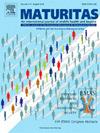Probability of progression and regression of chronic kidney disease in patients with type 2 diabetes mellitus
IF 3.9
2区 医学
Q2 GERIATRICS & GERONTOLOGY
引用次数: 0
Abstract
Objectives
To examine the annual transitions between the stages of diabetic kidney disease (DKD) in an Asian population with type 2 diabetes.
Study design
Longitudinal cohort study.
Main outcome measures
We analysed 15,913 clinic visits by 5980 patients (Chinese, Malay and Indian) who attended at least 2 annual primary care visits from 2010 to 2015, with DKD categorised into G1-G5 stages by estimated glomerular filtration rate. We applied a multistate Markov model adjusting for risk factors to estimate annual transition probabilities and sojourn times.
Results
Median (interquartile range) follow-up duration was 2.01 (1.11–2.93) years. Annual transition probabilities of progression from G1-G2 to G3 and G3 to G4-G5 were 1.26 % and 1.21 % respectively. Annual death rates among the G1-G2, G3 and G4-G5 groups were 0.92 %, 1.63 %, and 5.84 %, respectively. Estimated sojourn times in the G1-G2, G3 and G4-G5 groups were 43.73, 6.97, and 6.32 years, respectively. Among modifiable risk factors, progression from G1-G2 to G3 was associated with higher systolic blood pressure while death was associated with the presence of diabetic retinopathy, higher hemoglobin A1c (HbA1c) and lower body mass index.
Conclusions
Annual DKD progression in this screened population was slow but death from advanced stages was high. Ongoing surveillance and targeted control of risk factors such as blood pressure, HbA1c, and diabetic retinopathy may help improve outcomes.
2型糖尿病患者慢性肾脏疾病进展和消退的可能性
目的研究亚洲2型糖尿病人群中糖尿病肾病(DKD)分期的年度转变。研究设计:纵向队列研究。我们分析了5980名患者(华人、马来人和印度人)的15913次门诊就诊,这些患者从2010年到2015年每年至少进行两次初级保健就诊,根据肾小球滤过率将DKD分为G1-G5期。我们应用了一个调整风险因素的多状态马尔可夫模型来估计年转移概率和逗留时间。结果随访时间中位数(四分位间距)为2.01(1.11 ~ 2.93)年。从G1-G2到G3和G3到G4-G5的年过渡概率分别为1.26%和1.21%。G1-G2组、G3组和G4-G5组的年死亡率分别为0.92%、1.63%和5.84%。G1-G2、G3和G4-G5组的估计停留时间分别为43.73、6.97和6.32年。在可改变的危险因素中,从G1-G2到G3的进展与较高的收缩压相关,而死亡与糖尿病视网膜病变、较高的糖化血红蛋白(HbA1c)和较低的体重指数相关。结论在该筛查人群中,DKD的年度进展缓慢,但晚期死亡率高。持续监测和有针对性地控制危险因素,如血压、糖化血红蛋白和糖尿病视网膜病变可能有助于改善预后。
本文章由计算机程序翻译,如有差异,请以英文原文为准。
求助全文
约1分钟内获得全文
求助全文
来源期刊

Maturitas
医学-妇产科学
CiteScore
9.10
自引率
2.00%
发文量
142
审稿时长
40 days
期刊介绍:
Maturitas is an international multidisciplinary peer reviewed scientific journal of midlife health and beyond publishing original research, reviews, consensus statements and guidelines, and mini-reviews. The journal provides a forum for all aspects of postreproductive health in both genders ranging from basic science to health and social care.
Topic areas include:• Aging• Alternative and Complementary medicines• Arthritis and Bone Health• Cancer• Cardiovascular Health• Cognitive and Physical Functioning• Epidemiology, health and social care• Gynecology/ Reproductive Endocrinology• Nutrition/ Obesity Diabetes/ Metabolic Syndrome• Menopause, Ovarian Aging• Mental Health• Pharmacology• Sexuality• Quality of Life
 求助内容:
求助内容: 应助结果提醒方式:
应助结果提醒方式:


